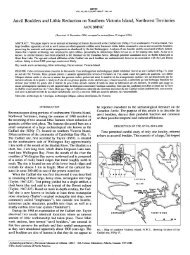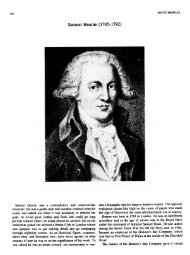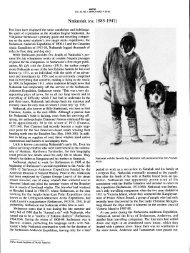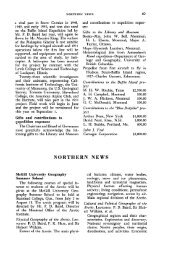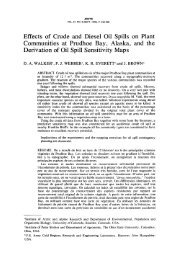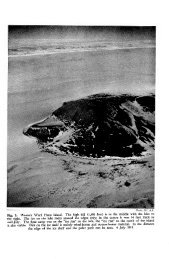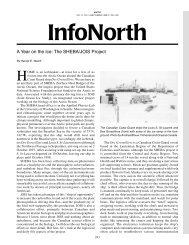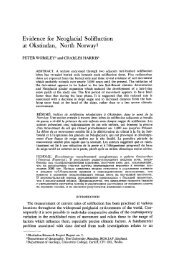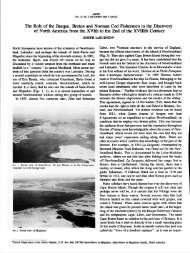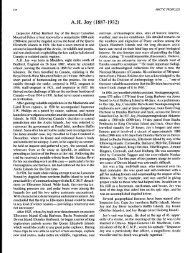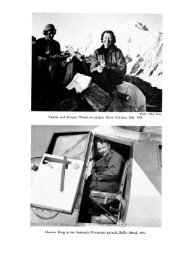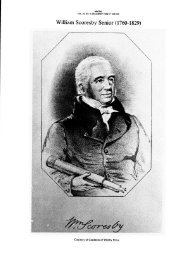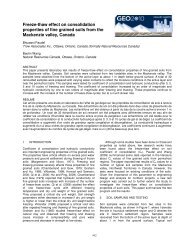NOTES ON THE NUNAMIUT ESKIMO AND MAMMALS OF ... - arctic
NOTES ON THE NUNAMIUT ESKIMO AND MAMMALS OF ... - arctic
NOTES ON THE NUNAMIUT ESKIMO AND MAMMALS OF ... - arctic
Create successful ePaper yourself
Turn your PDF publications into a flip-book with our unique Google optimized e-Paper software.
<strong>NOTES</strong> <strong>ON</strong> <strong>THE</strong> <strong>NUNAMIUT</strong> <strong>ESKIMO</strong> <strong>AND</strong><br />
<strong>MAMMALS</strong> <strong>OF</strong> <strong>THE</strong> ANAKTUVUK PASS REGI<strong>ON</strong>,<br />
BROOKS RANGE, ALASKA<br />
Robert Rausch”<br />
T<br />
HE Brooks Range, in northern Alaska, is biologically one of the least-known<br />
regions in North America. It has been during the last few years only that<br />
the use of light aircraft has made effective travel here possible. Since April<br />
1949, I have made field observations in the Anaktuvuk Pass country, in the<br />
central part of the range; this work, the investigation of animal-borne disease,<br />
has necessitated a thorough study of the indigenous mammals. It is the purpose<br />
of this paper to record information of a biological nature on these mammals,<br />
with special emphasis on their relationship to the local Eskimo, the last remnant<br />
of the once numerous Nunamiut.l<br />
The work has been carried out over a period of nearly three years and has<br />
of necessity been intermittent. I have made observations in all months except<br />
November and December, which are unfavourable for field work because of<br />
poor light conditions and lessened biological activity. Individual field trips<br />
have varied in length from ten days to nearly two months, and, in all, more<br />
than six months have besen spent in this region. Several months have also been<br />
spent nearer the Arctic Coast, from Wainwright to Lake Schrader, where<br />
comparative observations have been made. In addition, Mr. E. L. Schiller,<br />
of the Arctic Health Research Center, and others, have contributed<br />
observations.<br />
field<br />
After the first trips, because of transportation and supply problems, no<br />
camp was established and I lived among the Eskimo as one of them. This<br />
saved time by permitting more effective travel, but was particularly valuable<br />
in allowing greater insight into the<br />
learn something of their.language.<br />
lives of the people and an opportunity to<br />
Nunamiut words2 have been included in this paper whenever it was<br />
thought appropriate. The difficulties in writing Eskimo words phonetically<br />
are well recognized. However, through considerable personal effort towards<br />
learning the Nunamiut dialect, and with the aid of an educated, bilingual<br />
Eskimo living with this group, it is believed that a high degree of accuracy has<br />
been achieved.<br />
The work in the Brooks Range has been greatly facilitated by the generous<br />
cooperation of specialists in other fields of biology, by persons concerned with<br />
‘Arctic Health Research Center, US. Public Health Service, Anchorage, Alaska.<br />
1Nunamiut (“people of the land”) in this paper refers specifically to the Inland Eskimo<br />
formerly living from the Killik River to the Anaktuvuk River, but now existing as a small<br />
semi-nomadic group in the region of Anaktuvuk Pass.<br />
*All Eskimo words have been written phonetically, except that certain sounds repre-<br />
sented by the letter g, which do not occur in European languages, are not indicated, and ch<br />
following a or 0, and the letter i represent the same sounds as in the German language.<br />
147



